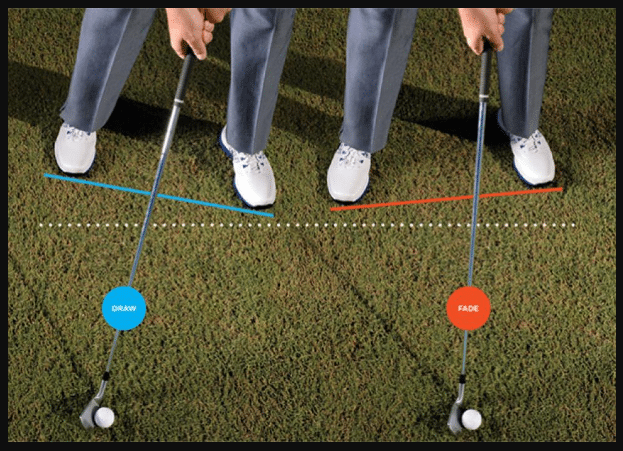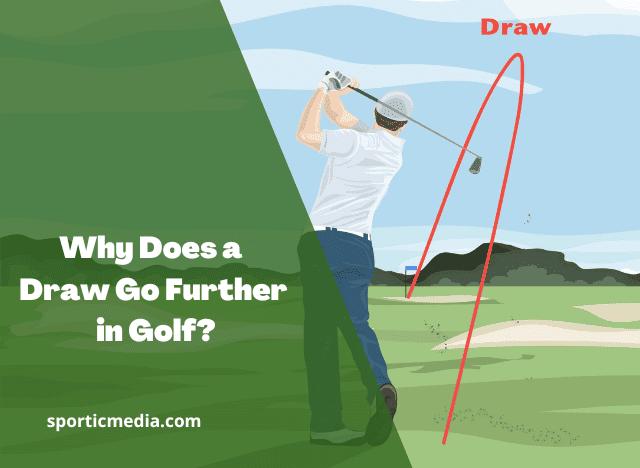In golf, the ability to shape shots is a prized skill. Two common shot shapes are the draw and the fade. Among these, the draw has gained a reputation for its impressive distance compared to the fade.
This article explores the scientific reasons behind this phenomenon, delving into the intricacies of spin, launch angles, and clubhead speed that contribute to the draw’s superior distance.
Table of Contents
Why Does a Draw Go Further in Golf? What factors effect it?
A draw in golf typically travels further than a fade for several reasons:
01. Reduced Slice Effect
A draw minimizes the side spin that is often seen in a slice (for right-handed golfers, a shot curving excessively to the right). This reduction in side spin allows the ball to maintain more forward momentum, contributing to increased distance.
02. Optimal Launch Conditions
Draws are usually associated with a lower launch angle and a more favorable spin rate compared to fades. These optimal launch conditions are key to maximizing distance.
03. Reduced Aerodynamic Drag
Draws exhibit lower sidespin, which affects the airflow around the ball and its spin axis. Lower sidespin results in less aerodynamic drag, allowing the ball to maintain a higher velocity and travel further.
04. Better Control of the Clubface
Hitting a draw generally requires a more centered strike on the clubface, leading to a more efficient energy transfer to the ball, increasing ball speed and, consequently, distance.
05. Utilization of the Entire Clubface
Draws promote an inside-out swing path, which often means a more effective use of the entire clubface. This increases the efficiency of the strike and can lead to greater distances.
06. Wind Considerations
Draws can be advantageous in windy conditions, as they can help the ball cut through the wind more effectively. The curvature of a draw (left-to-right for right-handed golfers) can be less affected by crosswinds, allowing for better distance control.
Other factors influencing the distance of a draw shot include club selection, swing speed, spin rate, angle of attack, and shot shape. Golfers aiming to maximize draw distance need to consider their grip, stance, weight shift, swing path, and follow-through.
The characteristics of the golf ball, such as compression, dimple design, cover material, size, and weight, also play a role. Additionally, environmental factors like wind, temperature, altitude, ground conditions, and humidity can impact the distance of a draw shot.
How do you fix a draw in golf?
To fix a draw in golf, there are several key adjustments and techniques to consider.
First, analyze your grip and ensure it is not excessively strong, as this can promote a draw. A more neutral grip will help promote a straighter ball flight.
Next, address your alignment and aim. Ensure your body is aligned parallel to the target line, as poor alignment can lead to unwanted curves.
Focus on your swing path and clubface position at impact. The clubface is closed to the swing path for draws, so work on squaring the face or opening it slightly at impact. Additionally, aim to swing along a more neutral swing path, avoiding an inside-out path that typically produces a draw.
Lastly, consider your weight distribution during the swing. Shifting weight to your lead foot at impact can help promote a straighter ball flight. Consistent practice and seeking guidance from a golf instructor will aid in making these adjustments and fixing your draw.
Do more pros hit a fade or draw?
Historically, many professional golfers favored a draw as it was believed to provide extra distance. However, the trend has shifted in recent years, and more pros have been adopting a fade as their preferred shot shape. A well-controlled fade can offer advantages such as increased accuracy and better handling windy conditions.
Ultimately, the choice between a fade and a draw comes from personal preference and what works best for the individual golfer. Some pros may still prefer to hit draws, while others opt for fades, and some can shape shots both ways as needed. The most successful golfers often possess the skill to execute both shot shapes, allowing them to adapt to different course layouts and weather conditions effectively.

How to hit a draw correctly in golf?
Hitting a draw in golf, where the ball starts right of the target and curves back towards it (for a right-handed golfer), is a skill that can add more control and distance to your shots. Here’s a guide on how to hit a draw effectively:
01. Setup: Begin by setting up with the proper stance, alignment, and grip. Your setup should be slightly right of your target, around five yards or so. This orientation is crucial for creating the right swing path for a draw.
02. Adjust Clubface and Grip: Square the clubface so that it’s aimed directly at the target, regardless of your feet’s alignment. You may also need to adjust your grip at this stage to facilitate a draw.
03. Low Takeaway: During the takeaway phase of your swing, keep the club low and slow. This helps in maintaining the right path and plane for a draw. If the club gets too high or outside this path, it becomes challenging to bring it back into a position that will produce a draw.
04. Shallow Swing Path: Ensure your swing is slightly shallow, especially when using a driver. This shallow path, approaching the ball from inside, is key for achieving the right-to-left ball flight in a draw.
05. Finish Strong: Extend your arms through impact and complete your swing with strength. Halting your swing abruptly or trying to control the club too much can disrupt the trajectory and distance.
For hitting a draw with a driver, ensure your driver shaft is swinging slightly below the traditional swing plane. When using an iron, the swing path needs to be inside-out but not as shallow as with a driver.
Remember, to consistently hit a draw, your clubface needs to be closed relative to the swing path. Initially, you might start hitting pull draws, but once you get the face closed, focus on swinging out to the right. Aligning the relationship between the face and the path correctly is essential for hitting a draw and other shot shapes.
These tips should set you on the right path to hitting a draw. It’s a skill that requires practice, so spending time on the range to get used to the feeling will be beneficial.
Conclusion
In conclusion, the draw’s ability to travel further in golf is attributed to its lower spin, reduced drag, higher launch angle, and potentially faster clubhead speed. These factors combine to create a powerful shot that maximizes distance. However, golfers should not disregard the fade, which offers its own advantages.
Ultimately, honing both shot shapes can empower golfers to navigate the course with precision and confidence, adapting to various situations and elevating their performance to new heights. As with any aspect of golf, consistent practice and a deep understanding of the mechanics involved will help golfers unlock the true potential of their shots and conquer the fairways with finesse.
Tour Speed Golf Balls Vs Tour Speed Soft Golf Balls; Must Read
SPORTIC MEDIA
Discover the meticulous and expert-driven process behind our product reviews at Sportic Media. Our comprehensive guide, led by industry veterans, ensures you get the most reliable and detailed insights into golf equipment. Dive into our methodical approach by visiting How We Test Products at Sportic Media: A Comprehensive Guide
.






